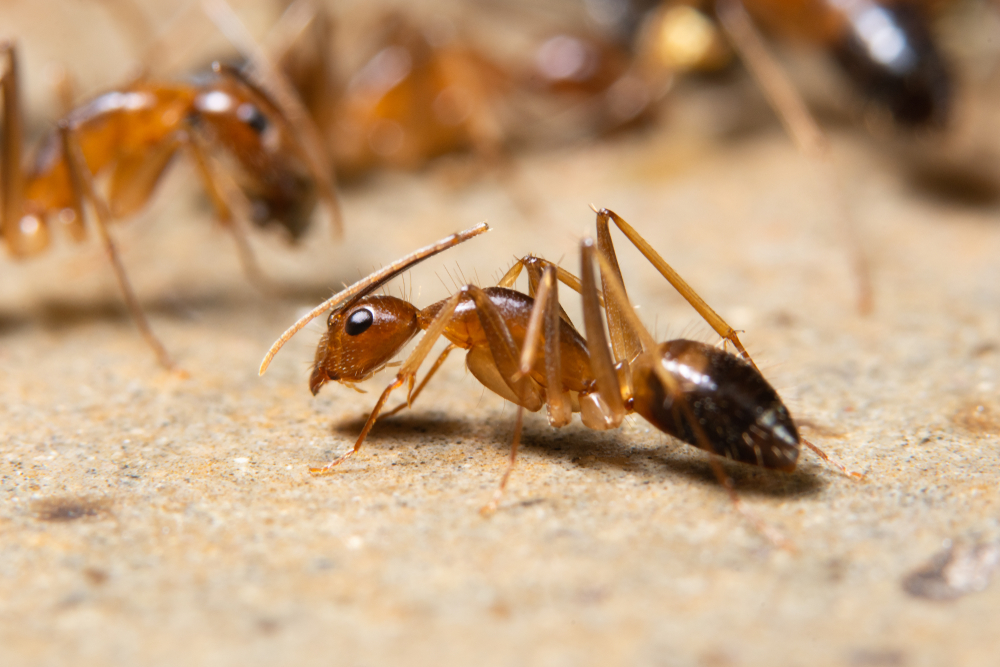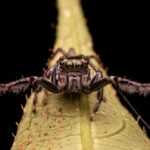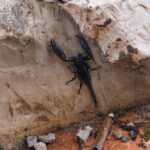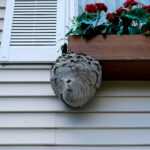Ghost Ant Control: Best Methods and Tips
Ghost ants are small, invasive tropical species that can quickly take over homes. If you’ve noticed these tiny, translucent ants around, you’re likely wondering how to identify ghost ants, where they nest, and how to eliminate them effectively. This article covers everything you need to know about ghost ants, from their appearance and behavior to proven control methods.
Ghost ants are small social insects with colonies that can rapidly expand, making early detection and intervention critical for successful ant control.
- Effective ghost ant management involves sanitation, baiting strategies, and the use of insecticides, along with ongoing monitoring to prevent reinfestation.
- Proactive measures such as moisture control, sealing entry points, and maintaining cleanliness are essential to prevent future ghost ant infestations.
Understanding Ghost Ants
Ghost ants (Tapinoma melanocephalum), believed to have originated from Africa or Oriental origin, have spread across various regions globally, particularly thriving in tropical and subtropical regions like Hawaii and Florida. These exotic ants are a common sight in the United States, often found in warm, humid environments.
What makes ghost ants particularly challenging is their social structure. Ghost ant colonies can range from 100 to 1,000 individuals and often contain multiple queens. This polygynous colony structure allows them to establish and expand rapidly, making it difficult to control their populations once they have infested an area.
Despite their small size, ghost ants are formidable structural pests. Their ability to adapt to different environments and their preference for nesting both indoors and outdoors make them a persistent problem for homeowners. Understanding their behavior and biology is the first step in effective ghost ant control.
Physical Description of Ghost Ants
Identifying ghost ants is crucial for effective pest control. These ghost ant workers are tiny, ranging from 1.3 to 1.5 mm in length, and have distinctive physical characteristics that set them apart from other ant species. Ghost ants have:
- a dark head and thorax, typically dark brown
- pale, almost translucent legs
- a pale, almost translucent abdomen
This unique coloration gives them a ghost-like appearance, hence their name.
Another distinguishing feature of ghost ants is their antennal scapes, which extend beyond the back of their head, and their 12-segmented antennae. Additionally, ghost ants have a slit-like anal opening on their gaster, a hairless thorax and abdomen, and a single node on their pedicel, setting them apart from other common house-infesting ants like the Pharaoh ant.
These physical traits are not just for show; they play a role in the ant’s biology and behavior. For instance, the pale legs and abdomen help ghost ants blend into their surroundings, making them harder to spot, while their unique antennal structure aids in navigation and communication within their colonies.
Nesting Habits and Locations
Ghost ants typically nest in a variety of locations, adapting to both indoor and outdoor environments. Indoors, ghost ants commonly nest in wall voids, potted plants indoors, spaces between cabinets, and under sinks, favoring warm, humid areas. This preference for moisture means they are often found in kitchens and bathrooms, making indoor colonies nesting a common occurrence.
Outdoors, ghost ants prefer moist environments such as soil, under rocks, leaf litter, rotten wood, and under loose bark. They also nest within palm fronds. In tropical and subtropical regions, such as Central and Southern Florida and the Caribbean Islands, these ants thrive due to the favorable climate. Regularly clearing debris and maintaining landscaping can eliminate potential outdoor nesting sites for ghost ants.
To prevent ghost ants from entering your home, it is essential to:
- Control moisture both inside and outside the house.
- Inspect your home for any cracks or gaps and seal them to block ant pathways.
- Understand that ghost ants leave behind pheromone trails, which can help in locating their nests.
- Learn about their nesting habits to take proactive measures against ghost ants.
Ghost Ant Infestation Signs
Detecting a ghost ant infestation early is crucial for effective control. One of the primary signs of a ghost ant infestation is observing ant trails and unusual ant activity, particularly in food-related areas like kitchens and bathrooms. Ghost ants are foragers, and their search for household foods often leads them to sinks, counters, and floors.
Another telltale sign of ghost ants is the distinct odor their workers emit when crushed, reminiscent of rotten coconuts. This unique smell can help identify ghost ants even if you haven’t seen them. By being vigilant and recognizing these signs, you can take prompt action to address the infestation before it becomes a more significant problem.
Feeding Preferences
Ghost ants have a sweet tooth, with a strong preference for sugary substances. They are commonly drawn to sugar, cakes, syrups, and other sweet foods. This dietary preference makes them frequent visitors to kitchens and pantries where such items are stored.
In addition to sweet foods, ghost ants also feed on honeydew, a sugary substance secreted by sap-sucking insects. They are opportunistic feeders and will also consume both dead insects and live insects, including small beetle larvae and lepidopterous larvae.
Understanding their feeding habits can help you better manage and prevent infestations by minimizing their access to food particles.
Effective Ghost Ant Control Methods
Controlling ghost ants requires a multi-faceted approach. Here are the key strategies to consider:
- Sanitation and Cleanliness: This is the first line of defense, reducing the availability of food and moisture that attract these ant pests.
- Baiting Strategies: These can be highly effective, especially when dealing with multiple nests and new colonies.
- Insecticides: These can be used to target and eliminate ghost ant populations directly.
By implementing these strategies, you can effectively manage and control ghost ant infestations.
Ongoing monitoring and maintenance are essential to ensure that ghost ants do not re-infest the area. Professional pest control services can provide customized treatment plans to address the unique conditions of your property. By combining these methods, you can achieve effective and long-lasting ghost ant control.
Sanitation and Cleanliness
Maintaining a clean environment is crucial in deterring ghost ants. Store food in sealed containers and keep the kitchen area free of crumbs and spills. Ghost ants are drawn to areas with food remnants, so regular cleaning is essential.
Natural repellents like lemon juice and cucumber can also be used to deter ghost ants from entering your home. These methods are not only effective but also environmentally friendly, providing a safe alternative to chemical repellents.
Baiting Strategies
Baiting is an effective method for controlling ghost ant colonies. Sweet baits can be made by combining one part borax with three parts powdered sugar and water. Protein-based baits, such as a mixture of borax and peanut butter, can also be effective.
It’s important to monitor the feeding behavior of ghost ants within a day or two after applying the bait. By observing which baits they prefer, you can adjust your strategy to maximize effectiveness. Baits can be particularly useful for controlling indoor colonies.
Insecticide Use
Insecticides are a powerful tool in the fight against ghost ants. Contact poisons can be particularly effective in managing ghost ant populations. Always follow safety guidelines, including wearing protective gear and ensuring adequate ventilation when using insecticides.
Insecticides should be applied directly to areas where ghost ants are prevalent, such as along ant trails and near nesting sites. This targeted approach ensures maximum effectiveness and helps to eliminate the infestation more quickly.
Preventing Future Infestations
Preventing future infestations involves addressing the factors that attract ghost ants. Moisture control is crucial, as ghost ants are often drawn to humid environments. Removing plants that attract ants or controlling other insects that produce honeydew can also help.
Maintaining cleanliness and sealing cracks and gaps in your home are essential steps in preventing ghost ants from entering and establishing colonies. Taking these proactive measures reduces the likelihood of future infestations and keeps your home pest-free.
Ghost ants are persistent and challenging ant pests, but with the right knowledge and tools, they can be effectively controlled. From understanding their behavior and nesting habits to implementing sanitation, baiting, and insecticide strategies, there are multiple ways to tackle a ghost ant infestation.
Professional pest control services provide specialized solutions for more complex infestations. By taking proactive measures and maintaining cleanliness, you can prevent future infestations and enjoy a pest-free home.
Frequently Asked Questions
How to get rid of ghost ants?
To effectively get rid of ghost ants, cleanse your living space and create an environment that deters them by removing food particles and moisture sources. If these methods fail, consider seeking professional pest control assistance.
Are ghost ants hard to get rid of?
Ghost ants are indeed challenging to eliminate due to their small size, polygynous colonies, and ability to infiltrate homes through tiny openings. Professional pest control services are often advisable for effective removal.
What states have ghost ants?
Ghost ants are primarily established in Florida and Hawaii, with reports of populations also occurring in various other states, Canada, Puerto Rico, and the Caribbean Islands. Their range is currently expanding within the United States.
What are ghost ants attracted to?
Ghost ants are primarily attracted to sweet foods like sugar, cakes, syrups, and honeydew from sap-sucking insects. Managing these food sources is essential to deter their presence.
How can I identify a ghost ant infestation?
Look for ant trails, increased ant activity in kitchens and bathrooms, and a distinctive odor that resembles rotten coconuts when the ants are crushed. These indicators can help confirm their presence in your home.




